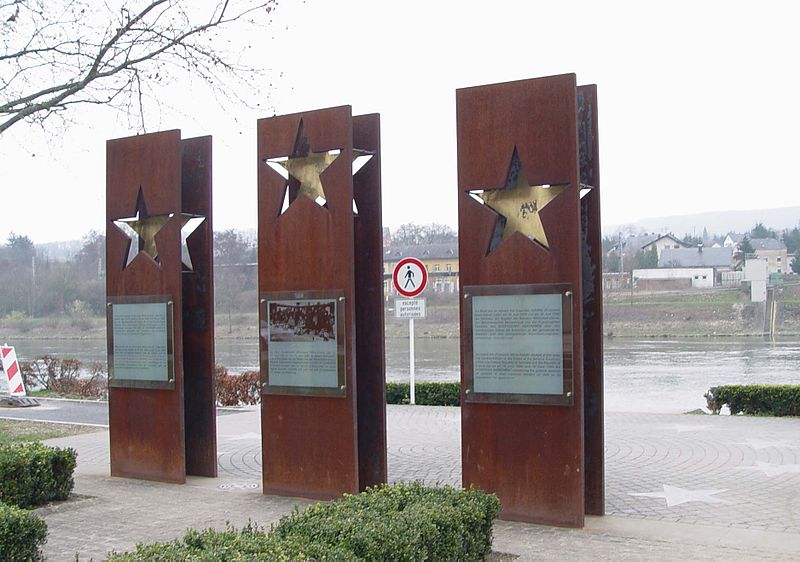A piece of Portugal in Luxembourg - Schengen
-
Difficulty:
-

-
Terrain:
-

Size:  (other)
(other)
Please note Use of geocaching.com services is subject to the terms and conditions
in our disclaimer.

The Schengen Agreement led to the creation of Europe's borderless Schengen Area in 1995. The treaty was signed on 14 June 1985 between five of the then ten member states of the European Economic Community near the town of Schengen in Luxembourg.
It proposed the gradual abolition of border checks at the signatories' common borders. Measures proposed included reduced speed vehicle checks which allowed vehicles to cross borders without stopping, allowing of residents in border areas freedom to cross borders away from fixed checkpoints and the harmonization of visa policies.
In 1990 the Agreement was supplemented by the Schengen Convention which proposed the abolition of internal border controls and a common visa policy. The Schengen Area operates very much like a single state for international travel purposes with external border controls for travellers entering and exiting the area, and common visas, but with no internal border controls. It currently consists of 26 European countries covering a population of over 400 million people and an area of 4,312,099 square kilometres (1,664,911 sq mi). Prior to 1999, the Schengen treaties and the rules adopted under them operated independently from the European Union, however the Amsterdam Treaty incorporated them into European Union law, while providing opt-outs for the only two EU member states which had remained outside the Area: Ireland and the United Kingdom.
Schengen is now a core part of EU law and all EU member states without an opt-out who have not already joined the Schengen Area are legally obliged to do so when technical requirement have been met. Several non-EU countries are also included in the area. Schengen, Luxembourg The free movement of persons was a core part of the original Treaty of Rome and, from the early days of the European Economic Community, nationals of EEC member states could travel freely from one member state to another on production of their passports or national identity cards. However systematic identity controls were still in place at the border between most member states.
Disagreement between member states led to an impasse on the abolition of border controls within the Community, but in 1985 five of the then ten member states, Belgium, France, Luxembourg, the Netherlands, and West Germany, signed an agreement on the gradual abolition of common border controls. The agreement was signed on the river-boat Princess Marie-Astrid on the river Moselle near the town of Schengen, Luxembourg, where the territories of France, Germany and Luxembourg meet. Three of the signatories Belgium, Luxembourg and the Netherlands had already abolished common border controls as part of the Benelux Economic Union. The Schengen Agreement was signed independently of the European Union, in part owing to the lack of consensus amongst EU member states over whether or not the EU had the competence to abolish border controls, and in part because those ready to implement the idea did not wish to wait for others (at this time there was no enhanced co-operation mechanism).
Schengen Area Legally bound to join The agreement provided for harmonisation of visa policies, allowing of residents in border areas freedom to cross borders away from fixed checkpoints and the replacement of passport checks with visual surveillance of vehicles at reduced speed vehicle checks that allowed vehicles to cross borders without stopping. In 1990 the Agreement was supplemented by the Schengen Convention which proposed the abolition of internal border controls and a common visa policy. It was this Convention that created the Schengen Area through the complete abolition of border controls between Schengen states, common rules on visas, and police and judicial cooperation. The Schengen Agreement along with its implementing Convention was implemented in 1995 only for some signatories, but just over two years later during the Amsterdam Intergovernmental Conference, all European Union member states except the United Kingdom and Ireland had signed the Schengen Agreement.
It was during those negotiations, which led to Amsterdam Treaty, that the incorporation of the Schengen acquis into the main body of European Union law was agreed along with opt-outs for Ireland and the United Kingdom, which were to remain outside of the Schengen Area. In December 1996 two non-member states Norway and Iceland signed an association agreement with the signatories of the Schengen Agreement to become part of the Schengen Area. While this agreement never came into force both countries did become part of the Schengen Area after concluding similar agreements with the EU.
The Schengen Convention was not open for signature by non-EU member states. A simple sign marks the border between Spain and Portugal Now that the Schengen Agreement is part of the acquis communautaire, the Agreement has, for its EU members, lost the status of a treaty, which could only be amended according to its terms; instead, its amendments are made according to that legislative procedure of the EU that covers the rules to be amended as defined in the EU treaties. Ratification by the former agreement signatory states is not required for altering or repealing some or all of the former Schengen-Acquis.
Legal acts setting out the conditions for entry into the Schengen Area are now enacted by majority vote in the legislative bodies of the European Union. New EU member states do not sign the Schengen Agreement as such; instead, they are bound to implement the Schengen rules as part of the pre-existing body of EU law, which every new entrant is required to accept. This led to the result that the Schengen States that are not EU members have few formally binding options to influence the shaping and evolution of the Schengen rules; their options are effectively reduced to agreeing, or withdrawing from the agreement.
Consultations with the affected countries are conducted prior to the adoption of particular new legislation. From Wikipédia
Additional Hints
(Decrypt)
OHFU
Ryyr a'rfg cnf cne greer